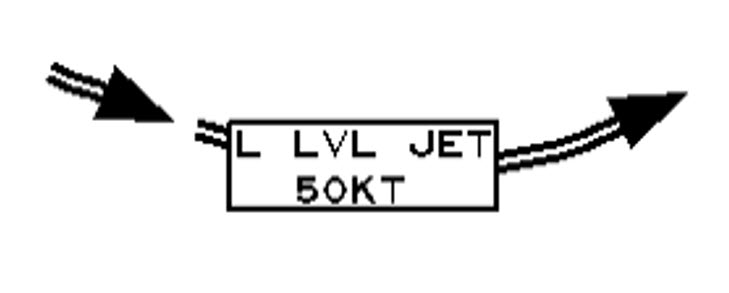







METAR Code
L LVL JET
Weather Symbol

A core of relatively high wind speeds, typically centered at altitudes ranging between 300 and 3000 feet above the ground, on occasion as high as 7000 feet.
Associated terms coming soon:
Inversion and low-pressure system are terms associated with a low-level jet that will be coming soon to the Aviation Meteorology Reference.

Low-level jet wind speeds usually range between 20 and 50 knots but can reach occasionally 100 knots or more and are typically found at the top of the boundary layer (the upper limit of the atmosphere which is most heavily influenced by being in contact with the earth’s surface). Although the vertical extent of the low-level jet ‘core’ is only a few hundred feet, the horizontal area covered by the jet varies extensively.
Low-level jets are important in meteorology, but especially in aviation meteorology because:
Image Source: Environment and Climate Change Canada
There are two primary mechanisms which can lead to the development of low-level jets:
Example of typical pre-frontal low-level jet location. As the jet lies in the warm sector, it accelerates transport of warm, humid air from the south deeper into the warm sector, which in turn helps fuel convection along the fronts, extending their lifespan.
Image Source: Environment and Climate Change Canada
While the two mechanisms outlined above are main processes by which low-level jets develop, other factors can affect the strength/location of a low-level jet:
Here is an example of speed differences in the low levels, surrounding the jet that can lead to severe low-level wind shear due to a low-level jet.
Image Source: Environment and Climate Change Canada
This is a case from 3 December 2021 where two low level jets in the warm sector of a deep low-pressure system are bringing severe turbulence and low-level wind shear to parts of Newfoundland. In this clouds and weather panel of the GFA, we see a wind barb of 35KT gusting 45KT along the south-east coast of Newfoundland.
The icing and turbulence panel from 3 December 2021 shows two low level jets in the warm sector of a deep low-pressure system are bringing severe turbulence and low-level wind shear to parts of Newfoundland. In this panel, we see the two low level jets depicted as well as an area of severe mechanical turbulence on the southeast coast of Newfoundland.
On the left is a tephigram and wind table from the upper air observation at St. John’s (CYYT) on 3 December 2021. This sounding shows a very saturated profile and strong winds in the lowest levels of the atmosphere. We see in the wind table that the maximum winds of 64KT are observed between 2500ft and 5000ft. However, we note that the highest wind shear values of roughly 25KT per 1000ft are observed between the surface and 2000ft. This corresponds with the PIREP observation in the SIGMET section that mentioned the most significant turbulence between 600ft-1900ft.
Image Source: Environment and Climate Change Canada
This image shows the reported winds at 1400Z on 03 December 2021 superimposed on satellite imagery. The red triangle is the plot of the PIREP in the SIGMET section. We see the strongest winds over eastern Newfoundland, with maximum reported winds of 40KT gusting 45KT.
Image Source: Environment and Climate Change Canada
Series of METARs from St. John’s, NL (CYYT) on 03 December 2021. The tight gradient and low-level jets associated with a deep low-pressure system brought strong winds and moderate to severe turbulence to the airport. We see in these observations that wind gusts were as strong as 44KT around 1100Z.
Image Source: Environment and Climate Change Canada
PIREP at 1400Z 03 December 2021 of moderate to severe turbulence from 600ft-1900ft on approach on runway 16 at St John’s (CYYT).
Possible turbulence, abrupt changes in windspeed/direction, compression and loss of airport efficiency, loss of lift if enhancing freezing precipitation in the area.

Operations Duty Managers
CYYZ/CYUL- The low-level jet is always included in the supervisor briefing at the start of the shift and often covers multiple sectors.
Is it performance increasing or decreasing (slowing or speeding up aircraft on downwind or final approach) and will it increase or decrease the number of aircraft per hour? Also known as “compression.”
In winter months, low-level jet questions also revolve around any events that include risk of freezing precipitation.
This phenomenon can have serious safety implications for Flight Operations if aircrew are not made aware of its presence. Aside from the turbulence that low level jets can create, the velocity of wind may induce fuel consumption beyond the flight planned amount, resulting in a potential insufficient fuel event. Terrain can also alter the impact from a low-level jet by causing significant wind shift/shear on transition from cruise to arrival. Surface winds can be nearly calm from one direction, but not far aloft the wind can be 40-60 knots from the opposite direction.
FIC
When PIREPs or forecasts indicate the presence of low-level jet(s), this will be included in the “Significant Threats to Aviation Safety” introduction at the start of the Pilot Briefing, after the Pilot indicates that their proposed flight will be operating within the approximate location of the low-level jet. PIREPs will be solicited, including the absence of any low-level jet – this is to confirm the motion of the low-level jet, and to verify that operations in that area have stabilized.
AAS
Advisory specialists rely solely on PIREPs to verify and monitor low-level jets and the associated L LVL WS. We will tailor our runway determination and advisories to account for it. Light winds at the surface may favour one runway, but not far aloft the strong winds favour another runway, which could alter the runway determination.
Strong winds below 10,000ft have an influence on the spacing required between aircraft on final. More space equals less capacity.
What most affects terminal ATC with this are tailwinds on approach.
When there is a tailwind, the amount of mileage we "lose" can go up to 2nm or even 3nm. This means that to finish with 3nm at the threshold, we must start with 5nm or 6nm between all our aircraft, same speed assigned. This greatly increases the workload for multiple reasons:
If there is a tailwind on final, there is a headwind on the downwind. Aircraft arriving "straight in" are way faster than usual, and aircraft on the downwind are way slower than usual.
The impact of low-level jets is two-fold.
Low-level jets can enhance the duration and intensity of freezing rain. If this occurs, an airport can see significant delays including temporary closure, and this will cause delays (see freezing rain for more details). If the consequence is strong winds, a couple of considerations must be taken into account:
If surface winds are in the same direction as winds within the core of the low-level jet, conditions are favorable in terminal for smooth operations and little compression.
If surface winds are opposite to winds in the low-level jet, this creates a much more complex situation. This can impact the distance between aircraft on final approach as traffic can slow down dramatically when they encounter the wind.
An example is in CYUL when winds are northeasterly at the airport but southwesterly aloft. Impacts:
If the wind is a crosswind on the primary runway, it may cause some overshoots, or some aircraft types may not be able to land at all.
En-route controllers deal with low-level jets indirectly. If there is reduced capacity due to strong winds, controllers will have to provide extra spacing between incoming aircraft as the terminal sectors will generally not be able to handle as much volume as normal.

A forecast for a low-level jet (or wind shear) at a regional airport is difficult to manage as it is often associated with severe turbulence SIGMETs.
Numerous East Coast and British Columbia airports have a reputation for low-level jet/wind shear events.
If we encounter a turbulence SIGMET associated with a low-level jet, it is a factor that we will take into consideration in our planning. Once again, the goal is to make sure we have a reliable alternate airport.
A common practice when departing an airport is to use a reduced thrust setting in order to reduce wear and tear on aircraft engines. This is not permitted when wind shear is present.
Along the St-Lawrence valley, a low-level jet commonly generates a strong tailwind in the first 3000ft of the initial climb.
A typical scenario in the St-Lawrence would be to have a northeasterly wind at the surface, with a strong tailwind at 3000ft. By experience, we expect that kind of condition with a warm front. A common verification that pilots will do when leveling off around 3000ft-4000ft is to note the wind at that altitude.
If a General Aviation (GA) pilot is aware of the presence of the low-level jet, they should also be aware of the presence of turbulence associated with it.
Even though upper wind forecasts can give an idea of conditions, GA pilots that have underestimated the effects of the low-level jet have often found a need to divert to another destination or sometimes even decide to return to their point of departure because the winds aloft were higher than predicted.
Pre-flight weather checks should include GFA and a weather briefing from the local FIC. Not following these crucial steps can lead to unwanted and even dangerous surprises in-flight.
Most GA aircraft and experienced pilots are capable of handling 30-35KT of headwind and around 15-20KT of non-gusting crosswind, however presence of gusts and variability in wind directions can create extra hazards and that’s why GA pilots are encouraged to develop a system of personal limits with respect to wind conditions.
Strong surface winds that may be related to a low-level jet aloft will also create hazards for small aircraft taxiing – they can be easily pushed around by the wind and less experienced pilots will have trouble controlling the aircraft.